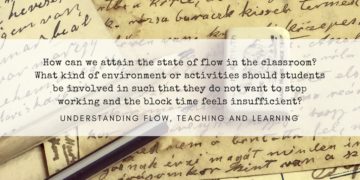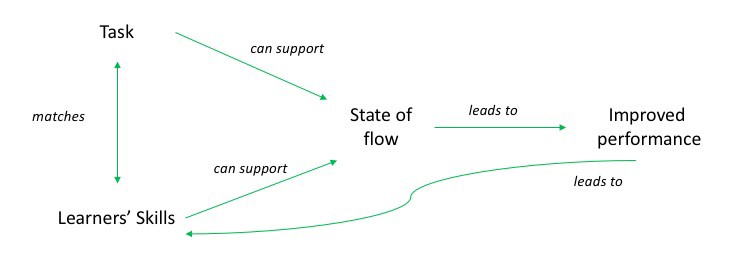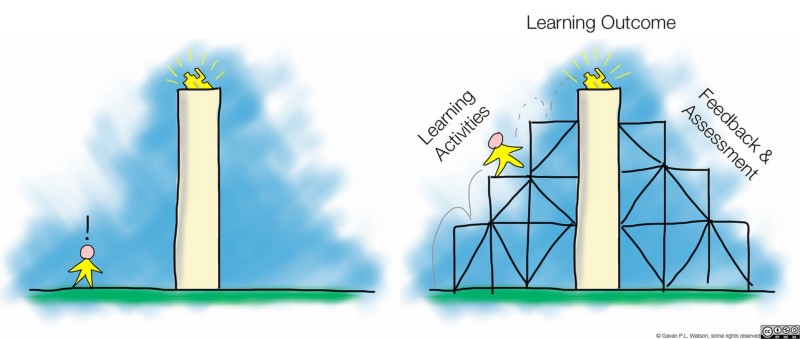We have all been ‘in the zone’ or lost track of time at some point in our lives. Maybe we were reading a book, having a conversation with a friend or playing a game, when we became so absorbed that we forgot about the time. I have experienced the state of flow while studying, playing video games, writing articles, reading novels… Often when I come out of the state of flow and find how much time has passed, I feel a little disappointed because I wanted more time to continue doing what I was doing. However, other parts of the routine are calling me, such as it is late and time for bed.
As a learner, flow is when I am focused on my task, to the point that I do not care about the time because I am having so much fun doing what I am doing. As a teacher, the following questions come to mind:

In this article, I try to answer these questions by analyzing the theory of flow developed by Mihaly Csikszentmihalyi. Based on my earlier description of state of flow and your own experience of it, you will realize that being in flow is internal and can be identified as intrinsic motivation — our personal need to continue doing something because we like it, rather than extrinsic where we aim for a reward after the activity is completed. Activities that lead to flow are called autotelic (auto=self, telos=goal) because they are enjoyable and they are not the means to an end — the process of being engaged is the end itself (Boniwell, 2008). Mihaly explored this concept of creativity and flow in his book, Creativity : flow and the psychology of discovery and invention (1997).
Maria Montessori’s philosophy of education emphasized flow as an important part of the development process of the child. She believed that deep concentration and flow were at the heart of education and lifelong development.
The paths the child follows in the active construction of his individuality are indeed identical with those followed by the genius. His characteristics are absorbed attention, a profound concentration which isolates him from all the stimuli of his environment. — Montessori on Spontaneous activity in education (Presentation link)
The state of flow can be attained by balancing the skills one possess with the challenges. Egbert (2004) analyzed the state of flow in foreign language acquisition and presented the relationship between tasks, learner skills, flow and performance, as shown below. When tasks and skills together support and lead to flow, performance improves, further developing the learners’ skill. This is applicable to other subjects areas as well because the tasks would be subject specific, the process itself would not change.

Flow Theory & Scaffolding
Wheeler (2016) puts the onus of engagement of students in lessons on the teachers — we have to make more interesting lessons, such that students stay focused. He explains Flow Theory as a way to engage students more effectively.
There is a fine balance between the challenge of the task, and the skills the learner has at their disposal. Maintaining this balance avoids disillusion if your skills don’t measure up to the challenge, or boredom if the task is too simple and easy to achieve. — Wheeler (2016)
This sounds a lot like the description for scaffolding. In scaffolding, the students works on a task which is in their Zone of Proximal Development, i.e., the task is a little beyond their current capabilities, and with the help of a more knowledgeable person, such as the teacher, the students can attain this knowledge and complete the task using the supports provided. If too many scaffolds are provided, it leads to boredom. If fewer scaffolds are given to the student, it leads to frustration with the task. Thus, flow is the state when the student actively works on achieving a goal: it is not a goal that will take a minute; it is not a goal that will take a week: it is a goal which will take a couple hours of concentrated effort and the student
(1) is interested in achieving the goal, a sense of control, and involvement in the task.
(2) has the necessary supports to achieve it, which including receiving feedback
(3) feels confidant that his skills can meet the challenge

As the complexity of the task increases, then according to flow, the learner’s skill should also increase, keeping him engaged in the process and time becoming immaterial. Students in state of flow have little awareness of the time passing, are intrinsically motivated to complete their work and are completely involved in it. The self-direction also leads to more energy. Thus, the state of flow happens when challenge is encountered that tests our skills and it is possible for us to use the skills we have to meet the challenge.
Flow and effective teaching
Mihaly (2014) emphasizes that the role of the educator should be to direct students’ energy towards productive goals. By putting ourselves in the shoes of the students, the learners, we can become better equipped to make our students see why something is important. He suggests the following characteristics that all teachers should keep in mind to facilitate flow:
- Bring the curriculum alive in the studies by showing its importance, relation to real life and application in the now: The teachers that students remember the longest are those who take notice of the student, that is, they are attentive to their needs and interests, and enjoy what they do, showcasing enthusiasm and excitement for learning.
- Teach the students to be able to give feedback to themselves: Feedback is an important aspect of flow. While playing a game of Mario Kart, for example, the game gives constant feedback in the form of my position with respect to others, seeing the other players being left behind or being taken over by them — all these situations in the environment lead me to change my strategy according — I can target players in front using objects from the mystery box; I should avoid muddy areas because my vehicle will slow down. A Math teacher I know designs his worksheets such that there are four levels of difficulty of questions: low, medium, high and advanced. The students choose to start at any level they are comfortable with and move up. The advanced questions are most challenging and are optional because they go beyond the curriculum. The teacher does not have answers for them and often he works with interested students to find solutions.
- Let the students become the teachers: This allows for matching skills of the students and letting them lead groups and the class at certain times. Often explaining a concept to someone can be exciting and engaging because it gets us thinking about how we learned it ourselves.
- Minimize distractions: All students want to be accepted. Learning happens in safe environments. By reducing distractions, such as avoiding actions that make students uncomfortable or threatened, focusing on the process of learning and working steadily towards clear well-defined goals, teachers will be able to create an environment where flow is possible.

As teachers, when we teach our students to monitor their own learning and to identify when they are ready for more challenging problems, whether they are satisfied with their solutions or not, they become independent.
How can we make learning irresistible?
The following are some practical ideas:
- Games and gamification: Students engage in games, whether on a digital device or physically. Games offer this fine equilibrium between challenge and skills (Chen, 2007). Thus, gamification or using game elements such as score boards and quests in the classroom, or game-based learning, using an actual video game to teach the curriculum, are some ways in which teachers can help students attain the state of flow.
- In an interview with Edutopia, Mihaly describes The Key Learning Community, a school that has succeeded in promoting flow. This is achieved by having a “Flow Room” where students spend at least a hour a week to explore and be involved in what they are interested in, and teachers actively try to translate their content matter into clear goals and challenges that match the students’ abilities. Students are involved by relating the curriculum to their interests. This is similar to the Genius Hour idea that many classes are adopting now where the students spend 20% of their class time creating things they are passionate about.
Maker movement can be added to this section too because it allows students to use their skills to solve a problem using the material at hand. In my previous experiences in Maker movement workshops, participants often forget time because of their engagement in the problem. There is constant feedback in the form of the design being unstable, breaking down often, for example.
- Differentiated instruction: The point above leads well into this one. Differentiated instruction is a proactive planning process that expresses the material in multiple ways and also allows learning to be showcased in multiple ways. It allows for the use of group work, individual work as well as whole class work as opportunities arise. As a student centred approach, it focuses on three characteristics of the student readiness, profile and interests aligned with the content (objectives of the syllabus the class time is dedicated to), the process (the activity that the students will do and class discussions), and the product (the worksheet for the day or any artifact that needs to be handed in to show the progress through the lesson). The state of flow is achieved by relating the curriculum to the student’s interests.
- Group objects and extracurricular activities: In the interview mentioned above, Mihaly builds a hierarchy of school activities that led to state of flow. Extracurricular like band, music, athletics, school newspaper are activities in which most students find state of flow. The students is the one who chooses them and probably has some interest in it. In band, for example, the student would have selected the instrument they play. Team work in classes also leads to state of work. Next comes working individually while listening to lectures and audio and videos is least likely to lead to flow.
John Spencer provides a fantastic infographic for ways in which teachers can boost student engagement using the flow theory. These link to most of the points I mentioned above. I highly recommend his detailed post for more ideas.
Conclusion
In his book, From Master Teacher to Master Learner (2015), Will Richardson asks the reader to answer this question: “What circumstances surrounded those moments when you found yourself truly immersed in the learning?” The thousands of teachers he has talked to have mentioned the state of flow as a condition that leads to powerful learning. Thus, if we integrate flow into our classroom by creating opportunities for students to challenge their skills and develop their interests further, it would lead to powerful, engaging learning.
References:
Boniwell, I. (2008). Living in Flow: What is it and how to enter the flow state? Retrieved from http://positivepsychology.org.uk/living-in-flow/
Chen, J. (2007). Flow in games (and everything else). Communications of the ACM, 50(4), 31–34.
Csikszentmihalyi, M. (2014). Applications of flow in human development and education : the collected works of Mihaly Csikszentmihalyi. Dordrecht, Netherlands: Springer.
Egbert, J. (2004). A study of flow theory in the foreign language classroom. Canadian modern language review, 60(5), 549–586.
Richardson, W. (2015). From master teacher to master learner. Solution Tree Press.
Wheeler, S. (2016). The Flow theory in the classroom: A primer. Retrieved from https://www.teachthought.com/learning/flow-theory-classroom-primer/

I really agree on this post and truly it’s helpful. It is amazing to be in Flow you can do all things naturally creatively, increasing work productivity, stress-free and more. I also read an interesting topic about flow at C Wilson Meloncelli website (https://www.cwilsonmeloncelli.com/flow-blog-2/). It tackles a lot of flow like how to get flow state quickly, how to get improvement in learning speed, etc. I strongly suggest it.
Thank you so much! I will take a look 🙂